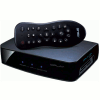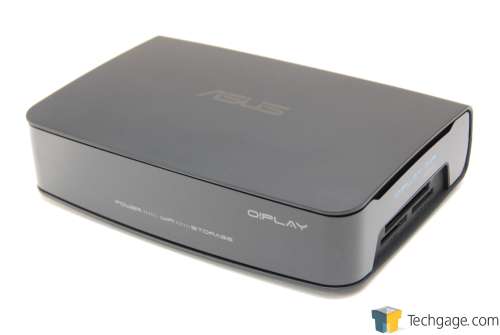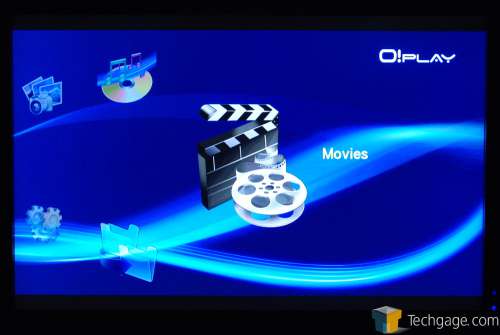- Qualcomm Launches Snapdragon 4 Gen 2 Mobile Platform
- AMD Launches Ryzen PRO 7000 Series Mobile & Desktop Platform
- Intel Launches Sleek Single-Slot Arc Pro A60 Workstation Graphics Card
- NVIDIA Announces Latest Ada Lovelace Additions: GeForce RTX 4060 Ti & RTX 4060
- Maxon Redshift With AMD Radeon GPU Rendering Support Now Available
ASUS O!Play Air Media Player

Have media on your PC, but want to watch it on anything but the PC? With ASUS’ O!Play, getting that job done is simple. Take 30 seconds to hook it up to a TV, and you can stream media through a network, or via external storage, such as eSATA or USB. It’s simple, and at $100, it’s not too hard on your pocketbook, either.
Page 3 – Usage Continued; Final Thoughts
Being that the O!Play is the first media player like this I’ve ever used for more than a couple of minutes, I cannot definitively state that it’s the best, or one of the best out there. But from the experiences I have had, I do like the device quite a bit, find it reliable, and also feature-robust. Do I see myself using it going forward? Yes.
There is a “problem” I need to get out of the way, though. While the O!Play supports 1080p, you can’t simply sit down and expect that all 1080p content is going to work without issue. Simply put, 1080p content is not going to work reliably over a wireless connection, if at all, and on wired, there are still going to be limitations.
In my testing, I had 1080p video ripped to MKV that played decently with a wireless connection, but there were random skips that made watching it a non-possibility. You don’t want to be watching a movie and have it skip… it’s just that simple. Via wired, 1080p MKVs played just fine… I had no issue at all.
What about the direct Blu-ray ISO rips that I mentioned in the intro? Well again, impossible on wireless, and sketchy on wired. This isn’t the fault of the O!Play by any stretch, because 1080p video can be extremely bandwidth-heavy, and if there’s a less-than-perfect network connection, issues could arise.
Since I’ve been having network issues ever since a recent router upgrade, the performance I saw with direct rips wasn’t too surprising, but ASUS states that as long as there isn’t any weird encoding going on, ISOs should play fine through a network. Unfortunately, I didn’t have an eSATA device lying around to test, but if I had to guess, it would have handled the direct rips a lot better than my NAS or USB device could stream them.
Also regarding these ISOs, due to various reasons, the menus and special features don’t work. Instead, loading the ISO will simply load the movie, which for most people might be fine. But, it does mean that you won’t want to be archiving your Blu-ray discs via the O!Play. If you want all of the functionality of a Blu-ray disc through this device, it’s best to just surf through a Blu-ray folder and play the .m2ts files that you need.
Blu-ray rips aside, all of the other video I played ran just fine on a wired connection, with no stuttering. Wirelessly, I found myself limited to 720p video, which is what I was expecting from the beginning. While some 1080p video might stream okay via a wireless connection, you’re truly going to need optimum conditions to see it happen.
Music is almost a non-issue, as it requires much less bandwidth than video. MP3, FLAC or WAV, you’re going to be able to listen to your music without stuttering, even with wireless. Of course, given that a wireless connection is prone to dropped or sketchy signals, you might still not get perfect playback if you’re connection isn’t solid. If you don’t have a ton of interference, and have a reliable router, this will be a non-issue.
Likewise, pictures require little bandwidth, so viewing those are a relative breeze. I do have two minor complaints though. The primary one is that browsing pictures is a bit clunky, and at times, it would take up to three seconds to forward to the next photo. Most often, it took just 1~1.5s, but any delay is quite noticeable when you’re intently looking at a screen. At the same time, large files I tried to look at wouldn’t load at all (10 megapixel).
Because the resolution of the O!Play for most people will be 1080p, if you have images with a greater height, such as 1920×1200, the top and bottom excess will be cut off. You can zoom in a bit and scan the entire picture to see it all (which in itself is slow and a bit painful), but in a slideshow, if the picture doesn’t fit perfectly, you can expect part of it to get cut off. Ideally, the O!Play should constrain both the width and height, or at least give an option.
I might seem like I’m harping on all the downsides quite badly here, but that’s because there’s not too much to say about the upsides, because as I mentioned, the O!Play for the most part handles what it’s supposed to do quite well. Even with its minor issues, I plan on using the device going forward, until I find something more feature-rich or more reliable. For what I need, the O!Play suits me just fine, and does what I need it to.
If you want a media streamer that’s easy to setup and use, the O!Play isn’t going to be a regrettable purchase. I was expecting something complicated to deal with, but was very pleasantly surprised. And at $100, it’s a rather affordable product as well. With ASUS promising to keep it alive for a while yet with firmware updates, it’s even a little bit future-proof.
Where Non-Air vs. Air comes into play, I’d only recommend the Air if you don’t require 1080p playback, because quite simply, you’re not going to have that without issue. Instead, the non-Air version would be best, or the intent to use external storage. Even then, for the heaviest high-definition files, eSATA is really going to be the only way to go. Even most USB drives could stall with the highest bandwidth HD rips out there.
In the near-future, I plan to get more media players like the O!Play in and see what else is available, so if you’re interested in such comparisons, stay tuned to the site. As for the O!Play itself, its future version promises to be even more feature-rich, so I look forward to learning about that as months pass. To my knowledge, that’s not slated to be released until this winter, so we do have a little bit of waiting until then.
Discuss this article in our forums!
Have a comment you wish to make on this article? Recommendations? Criticism? Feel free to head over to our related thread and put your words to our virtual paper! There is no requirement to register in order to respond to these threads, but it sure doesn’t hurt!
Support our efforts! With ad revenue at an all-time low for written websites, we're relying more than ever on reader support to help us continue putting so much effort into this type of content. You can support us by becoming a Patron, or by using our Amazon shopping affiliate links listed through our articles. Thanks for your support!







